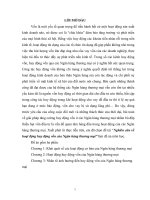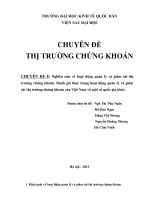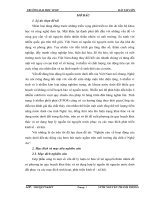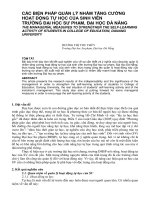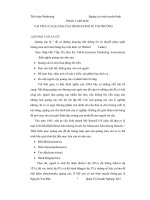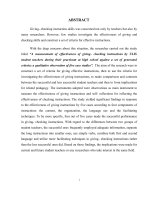Nghiên cứu về hoạt động tranh luận của sinh viên bằng kép năm 2
Bạn đang xem bản rút gọn của tài liệu. Xem và tải ngay bản đầy đủ của tài liệu tại đây (2.22 MB, 83 trang )
VIETNAM NATIONAL UNIVERSITY, HANOI
UNIVERSITY OF LANGUAGES AND INTERNATIONAL STUDIES
FACULTY OF ENGLISH LANGUAGE TEACHER EDUCATION
GRADUATION PAPER
AN INVESTIGATION INTO DEBATES OF
DOUBLE-MAJOR SOPHOMORES
Supervisor: Vũ Thị Việt Hương
Student: Hứa Kim Ngân
Course: QH2014.F1.E2
HÀ NỘI - 2018
ĐẠI HỌC QUỐC GIA HÀ NỘI
TRƯỜNG ĐẠI HỌC NGOẠI NGỮ
KHOA SƯ PHẠM TIẾNG ANH
KHÓA LUẬN TỐT NGHIỆP
NGHIÊN CỨU VỀ HOẠT ĐỘNG TRANH LUẬN CỦA
SINH VIÊN BẰNG KÉP NĂM 2
Giáo viên hướng dẫn: Vũ Thị Việt Hương
Sinh viên: Hứa Kim Ngân
Khóa: QH2014.F1.E2
HÀ NỘI - 2018
ABSTRACT
Debate is a notable activity applied in different fields, especially in teaching
and learning English as a second language. Henceforth, this research scrutinized into
the debate activity of 59 double-degree sophomores in FELTE, ULIS. After a long
process of data analysis and synthesis with the assistance of qualitative and
quantitative methods (via observation, questionnaire and interview), it has been
unveiled that there were a large number of not only plus points but also drawbacks
when implementing debate on these kinds of participants. Students claimed that their
language skills, idea brainstorming skill, argumentation skill, critical thinking skills,
several language elements, soft skills, vocabulary, background knowledge, polite
manner and bias reduction were significantly improved. On the other hand, external
factors such as the lack of technological devices, heavy workload along with internal
factors, namely the students’ lack of confidence, limited background knowledge,
time management skill, bias towards subject matter, weak non-verbal languages or
weak language proficiency, led to numerous challenges for the students involved.
LIST OF ABBREVIATIONS AND CONVENTIONS
CLT: Communicative Language Teaching
FELTE: Faculty of English Language Teacher Education
SPAR: Spontaneous Argumentation
ULIS: University of Languages and International Studies
VNU: Vietnam National University
%: percent
REFERENCES
Colbert, K. R., & Biggers, T. (1986). Why should we support debate? Journal of the
American Forensics Association, 14, 14-35.
Colbert, K. R. (1993). The effects of debate participation on argumentativeness and
verbal
aggression,
Communication
Education.
Retrieved
from
/>Dahlberg, L. & McCaig, C. (2010). Practical research and Evaluation: A Start-tofinish Guide for Practitioners. Los Angeles: Sage.
Dickson (2004). Developing “Real-world intelligence”: Teaching argumentative
writing through debate. English Journal, 21, 50-52.
Dörnyei, Z. (2007). Research methods in applied linguistics. New York: Oxford
University Press.
Facione, P. A. (1990). Critical Thinking: As Statement of Expert Consensus for
Purposes of Educational Assessment and Instruction. Retrieved from
/>atement_of_Expert_Consensus_for_Purposes_of_Educational_Assessment_an
d_Instruction
Faculty of English Language Teacher Education, ULIS. (2015). Course guide:
English for Academic Purposes 4.
Hua, P. L. (2017). Using debates to promote sophomores’ engagement in a speaking
classroom of academic English. Victoria University, Melbourne Australia.
Iberri-Shea, G. (n.d.). Teaching English through debate in classroom contexts.
Retrieved from />Karakaş, A. (2013). Is Communicative Language Teaching a Panacea in ELT? Student
and
Teacher
Perspectives.
Retrieved
from
/>guage_Teaching_a_Panacea_in_ELT_-_Student_and_Teacher_Perspectives
Le, T. P. A. (2012). An Introduction to Research Methodology in Foreign
Language Education. Hanoi: Vietnam National University.
Lewis, L. M & Wakefield, J. A. (1983). Teaching psychology through an instructordebate format. Teaching of Psychology.
Mackey, A., & Gass, S. M. (2005). Second language research: Methodology and
design.
Retrieved
from
/>e%20Methodology%20and%20Design.pdf
Mark, T., Canale, S., & Baker, J. (1997). Impacts of using debate in a speaking
classroom. ELT Journal, 36, 99.
Ministry of Education and Training. (2008). National Foreign Languages 2020
Project. Retrieved from />Najafi, M. , Motaghi, Z., Nasrabadi, H.B. & Heshi, K.N. (2016). "Debate" learning
method and its implications for the formal education system. Retrieved from
/>National Forensic League. (2009). Guide to Public Forum Debate. Retrieved from
/>National Science Foundation. (2002). The User-Friendly Handbook for Project
Evaluation.
Retrieved
from
/>Parcher , J. (1998). The Value of Debate: Adapted from the Report of the Philodemic
Debate
Society,
Georgetown
University,
1998.
Retrieved
from
/>Scott, S. (n.d.). Perceptions of Students’ Learning Critical Thinking through Debate
in
a
Technology
Classroom:
A
Case
Study.
Retrieved
from
/>&type=pdf
Snider, A., & Schnurer, M. (2006). Many Sides: Debate Across the Curriculum. New
York: International Debate Education Association.
Snider, A. C. (n.d.). Debate: Key to better academic achievement. Retrieved from
/>
Vangelisti, A. L., Daly, J. A., & Friedrich, G. W. (2009). Teaching Communication:
Theory, Research, and Methods (2nd ed.). New York: Routledge.
Vargo,
S.
P.
(2012).
Teaching
by
debate.
Retrieved
from
/>Vo, H. X. & Morris, R. L. (2006). Debate as a tool in teaching economics: Rationale,
technique, and some evidence. Journal of Education for Business, 20, 88.
Watson, G. & Glaser, E. (1980). Critical thinking appraisal manual for forms A and
B. New York: Harcourt Brace Jovanovich.
Želježič,
M.
(2017).
Debate
in
the
EFL
Classroom.
/>
Retrieved
from
LIST OF TABLES
Table 1: Skill description (Course guide: English for Academic Purposes 4) ......... 12
Table 2: Debate sequence (Course guide: English for Academic Purposes 4) ......... 13
Table 3: Teacher evaluation form for inclass debate (Course guide: English for
Academic Purposes 4) ............................................................................................... 14
i
LIST OF FIGURES
Figure 1: Public Forum Debate Format (National Forensic League, 2009) ............... 9
Figure 2: Spontaneous Argumentation ..................................................................... 10
Figure 3: Roundtable discussion ............................................................................... 11
Figure 4: Listening skills and Reading skills ............................................................ 21
Figure 5: Idea brainstorming skill ............................................................................. 22
Figure 6: Argumentation skill ................................................................................... 22
Figure 7: Critical thinking skills ............................................................................... 23
Figure 8: Soft skills ................................................................................................... 24
Figure 9: Vocabulary................................................................................................. 25
Figure 10: Pronunciation ........................................................................................... 25
Figure 11: Grammar .................................................................................................. 26
Figure 12: Fluency and Coherence ........................................................................... 26
Figure 13: Non-verbal languages .............................................................................. 27
Figure 14: Other benefits .......................................................................................... 28
Figure 15: Listening skills and Reading skills .......................................................... 29
Figure 16: Idea brainstorming skill ........................................................................... 30
Figure 17: Argumentation skill ................................................................................. 30
Figure 18: Critical thinking skills ............................................................................. 31
Figure 19: Soft skills ................................................................................................. 32
ii
Figure 20: Vocabulary............................................................................................... 33
Figure 21: Pronunciation ........................................................................................... 34
Figure 22: Grammar .................................................................................................. 34
Figure 23: Fluency and Coherence ........................................................................... 35
Figure 24: Non-verbal languages .............................................................................. 35
Figure 25: Other difficulties ...................................................................................... 36
Figure 26: Teamwork ................................................................................................ 37
Figure 27: The opponent team .................................................................................. 38
Figure 28: Other difficulties ...................................................................................... 39
iii
TABLE OF CONTENTS
LIST OF TABLES ..................................................................................................... i
LIST OF FIGURES .................................................................................................. ii
TABLE OF CONTENTS ......................................................................................... iv
CHAPTER 1: INTRODUCTION ............................................................................ 1
1. Statement of problem and rationale for the study ....................................... 1
2. Aims and objectives ........................................................................................ 2
3. Scope of the study ............................................................................................ 2
4. Significance of the study ................................................................................. 2
5. Organization of the study ............................................................................... 3
CHAPTER 2: LITERATURE REVIEW ................................................................ 4
2.1. Debate activity ................................................................................................. 4
2.1.1. Definition of debates ............................................................................... 4
2.1.2. Benefits of debates in teaching and learning English as a second
language............................................................................................................... 5
2.1.3. Drawbacks of debate in teaching and learning English as a second
language............................................................................................................... 8
2.1.4. Debate models......................................................................................... 8
a.
Public Forum Debate .................................................................................. 9
b. Spontaneous Argumentation ......................................................................... 9
c. Roundtable discussion ................................................................................. 10
2.2. Debates in English speaking lesson in Double-major Program, ULIS,
VNU ...................................................................................................................... 11
2.2.1. Objectives of the debate activity in English speaking lesson in Doublemajor Program .................................................................................................. 11
2.2.2. Format of the debate activity in English speaking lesson in Doublemajor Program .................................................................................................. 12
iv
2.2.3. Assessment criteria ............................................................................... 13
CHAPTER 3: METHODOLOGY ......................................................................... 16
3.1. Participants .................................................................................................... 16
3.2. Research instruments ................................................................................... 16
3.2.1. Questionnaires ..................................................................................... 17
3.2.2. Videotaping and audio recording ......................................................... 17
3.2.3. Observation sheet ................................................................................. 18
3.2.4. Interviews .............................................................................................. 18
3.3. Data collection procedures ........................................................................... 18
3.4. Data analysis tools ......................................................................................... 19
3.5. Data analysis procedures .............................................................................. 19
CHAPTER 4: FINDINGS AND DISCUSSION ................................................... 21
4.1. Question 1: From students’ perspective, what benefits do they gain from
the debate activity? .............................................................................................. 21
4.2. Question 2: From students’ perspective, what are the difficulties they
encountered during this activity? ...................................................................... 29
CHAPTER 5: CONCLUSION ............................................................................... 41
5.1. Conclusion and implications........................................................................ 41
5.2. Limitations ..................................................................................................... 42
5.3. Suggestions for further research ................................................................. 43
REFERENCES ........................................................................................................ 44
APPENDICES ......................................................................................................... 47
APPENDIX 1 ....................................................................................................... 47
APPENDIX 2 ....................................................................................................... 48
APPENDIX 3 ....................................................................................................... 52
APPENDIX 4 ....................................................................................................... 62
v
APPENDIX 5 ....................................................................................................... 63
vi
CHAPTER 1: INTRODUCTION
This part outlines statement of problem and rationale for the study, states its
aims and objectives, scope, significance and ends with the organization of the paper.
1. Statement of problem and rationale for the study
It is common knowledge that there has existed an accelerating demand for
English in general and effective communication in particular. A myriad of novel
teaching approaches have changed English language teaching due to that trend. Being
one of those most newly notable methodologies, Communicative Language Teaching
(CLT) had been widely accepted by language teachers on a global scale since its
emergence in the 1970s (Karakaş, 2013).
At the end of September 2008, Ministry of Education and Training (MOET)
officially enforced „„National Foreign Languages 2020 Project‟‟ pointing out national
educational missions related to English language teaching. This project showed
considerable concern for the utilization of CLT in educational public institutions in
Vietnam. In other words, students‟ oral skills have been of paramount importance.
Under this project‟s requirements, at University of Languages and
International Studies (ULIS), Faculty of English Language Teacher Education
(FELTE) modified English curriculum for mainstream sophomores. The new one
integrated four previously separated skills namely Reading, Listening, Writing and
Speaking into solely two subjects called English for Social Purposes and English for
Academic Purposes.
With the purpose of enhancing learners‟ presentation, debate and critical
thinking skills which are crucial to good communicative competence in reality,
FELTE made debate one of two main projects in the subject of English for Academic
Purposes. This project has been applied for double-major sophomores as well.
Debates have been applied in a wide variety of fields; for instance, politics as
well as language teaching and learning. According to Snider and Schnurer (2006,
p.207), debates had proved to be prominently productive exercises for language
acquisition. At ULIS, VNU, there were only two research papers on the topic of
1
debate. The first one belonged to English for Academic Purposes, but it was only
restricted to the improvement of critical thinking skills via debate, and the second was
relevant to Fast-track program project, about fallacies. Between these two, nothing
was a general investigation into debate. To the best knowledge of the researcher, no
one used to thoroughly examine debate after its three years of implementation,
especially on double-major learners. Consequently, so as to fulfill that gap, the
researcher decided to conduct a research entitled ‘‘An investigation into debates of
double-major sophomores’’.
2. Aims and objectives
Meanwhile, in order to reach the target of „„National Foreign Languages 2020
Project‟‟, exploring benefits of conducting debate on English speaking classes and
challenges that students meet during debate procedure is an indispensable mission.
This study is aimed to discover those factors taking place in debate classes of doubledegree sophomores, Faculty of English Language Teacher Education, ULIS, VNU.
In brief, the research purports to address the following questions:
1. From students‟ perspective, what benefits do they gain from the debate activity?
2. From students‟ perspective, what are the difficulties they encountered during this
activity?
3. Scope of the study
It should be noted that the sample of this study is limited to two classes with
59 double-degree sophomores in the academic year of 2017 - 2018 in FELTE, ULIS,
VNU.
4. Significance of the study
Gall (as cited in Vangelisti, Daly, & Friedrich, 2009) demonstrated that
interactive formats are applied for gaining critical thinking, problem-solving ability,
attitude change, higher level cognitive learning, moral development and
communication skill enhancement. Besides, „„debate is also a successful method of
teaching because of its inherently interactive format‟‟ (Parcher, 1998). Hence, for the
best utilization of debate, the findings of this study are expected to be beneficial for
2
not only students, teachers but also course developers. This research can bring about
knowledge of the benefits and shortcomings of the debate implementation, thereby
enhancing their awareness in general and acting as a recommendation for the teachers
along with the course developers to redesign that project in a more appropriate way in
particular.
5. Organization of the study
The study consists of five chapters:
Chapter 1 – Introduction copes with the statement of problem and rationale,
aims and objectives, scope, significance of the research as well as the organization of
the study. This part helps the audience to gain an overview look about the research.
Chapter 2 – Literature Review demonstrates fundamental and theoretical
grounds for the research, with the explanation of the definitions of debate, the
benefits and shortcomings of debate in teaching and learning English as a second
language, debate models and a brief overview of debate activity in English speaking
lesson of double-degree sophomores.
Chapter 3 – Methodology presents detailed information about the participants,
the research instruments, the procedure of data collection, data analysis tools and the
data analysis process.
Chapter 4 – Findings and Discussion shows the results from the observation,
questionnaire and interview and finding discussion.
Chapter 5 – Conclusion summarizes the major findings of the study along
with its limitations, and proposes suggestions for future studies. This chapter gives an
overview of the results and assists them in recognizing the significance of the study.
3
CHAPTER 2: LITERATURE REVIEW
This chapter provides a brief review of the literature related, the background
and a number of studies related to the research topic in particular. The key term
‘‘debate’’ will be defined together with its sub-related issues such as the benefits,
shortcomings in teaching and learning English as a second language and some
debate models. An overall view of debates in English speaking lesson in Doublemajor Program, ULIS, VNU is also discussed in details.
2.1.
Debate activity
2.1.1. Definition of debates
In the current formal education system, debate activities become more and
more prevalent among different teaching methods. The utilization of debates is an
outstanding phenomenon in education, specifically in foreign language teaching.
Najafi, Motaghi, Nasrabadi and Heshi (2016) defined „„the debate, which means
scratching and digging, is a kind of dialogue to find answer or solution‟‟. In other
words, individuals share their viewpoints and listen to each other on the same topic.
Agreeing with this idea, professor Kennedy (as cited in Vargo, 2012) stated
that “Debate refers to the process of considering multiple viewpoints and arriving at a
judgment, and its application ranges from an individual using debate to make a
decision in his or her own mind to an individual or group using debate to convince
others to agree with them.‟‟ Meanwhile, McGough (as cited in Colbert, 1993) had an
interesting view about debates when visiting a high school workshop and compared
debates as "dungeons and dragons, the thrill of combat, and an imaginary universe"
making it like "war games". According to Želježič (2017), formal debates were
commonly recognized in public meetings where people freely supported a random
side; on the contrary, at universities, participants were basically assigned a particular
side for which to advocate.
Regarding the number of sides, Snider and Schnurer (2006, p.6) argued that
there were two or more sides in a debate. Nevertheless, Želježič (2017) ensured that
debate was a formal information exchange where only two opposing sides
participated in. This also matches the opinion of the researcher as she considered a
4
debate involving various teams but only two sides entitled proponent as well as
opponent ones. The former supports the topic resolution and the latter protects the
contrasting ideas.
As cited in Parcher (1998), Matlon and Keele concluded that "there is an
affirmative relationship between participation in competitive debate and the goals of
higher education". Supporting this idea, Colbert and Biggers (1986, p.14) agreed
"training in debate has long been considered a vital part of the educational process".
Finally, Kruger (as cited in Parcher, 1998) assured that debate was the most
„„valuable‟‟ activity in a liberal arts curriculum.
2.1.2. Benefits of debates in teaching and learning English as a second language
A plethora of researchers endorse the implementation of debates in the
classroom because debates exert a great positive academic impact on the learners
partaking in its procedure.
Soraya (as cited in Najafi et al., 2016) believed that debates had a considerable
effect on the mental aspect of the human mind. According to Vo & Morris (2006,
p.88), debates increased the plus points of the traditional lecture by engaging the
learner in the material. Nasirodin Toosi (as cited in Najafi et al., 2016) complimented
that participating in the process of "debate" was better than a one-month repetition of
a lesson. A working group of the Quail Roost Conference on Assessment of
Professional Activities of Directors of Debate (as cited in Parcher, 1998)
also
claimed „„the benefits derived from debate thus seem particularly appropriate for, and
consistent with, the emerging concerns and trends in higher education.‟‟ Below are
potential advantages that debate activity brings about.
In the first place, almost all of the reviewed research revolves around critical
thinking abilities which are considered the most notable skills improved from debate
activity. Debate could be seen as one of the best methods of learning and applying the
principles of critical thinking (Freely, as cited in Parcher, 1998). Vargo (2012)
regarded that debate offered an opportunity for students to move beyond the
acquisition of basic knowledge and go into higher critical thinking skills. Colbert and
Biggers, (1986, p.16), Parcher (1998), Walker and Warhust (as cited in Scott, n.d.),
5
Dickson (2004, p.50) and Akerman and Neale (as cited in Želježič, 2017) shared a
view in common about increasing critical thinking through the use of persuasive
evidence with the assistance of debate activity. Critical thinking skills „„include the
ability to define a problem, select pertinent information for the solution of a problem,
recognize stated and unstated assumptions, formulate and select relevant and
promising hypotheses, and draw valid conclusions and judge the validity of
inferences‟‟ (Watson & Glaser, as cited in Želježič, 2017). On the other hand,
Facione (1990) came up with six clearer categories of critical thinking skills with
Interpretation, Analysis, Evaluation, Inference, Explanation and Self-regulation (Selfreflection). The research follows this framework due to its unambiguous
classification.
According to Dickson (2004, p.52), Akerman and Neale (as cited in Želježič,
2017), team-working skill would be also developed thanks to debates. The
collaboration among team members allowed individuals to memorize information
longer which was helpful for studying purpose (Gokhale, as cited in Vargo, 2012).
Besides, Parcher (1998) along with Akerman and Neale (as cited in Želježič,
2017) witnessed remarkable gains in research skills. The reason was that conducting
extensive research was always simulated during the whole debate process (Colbert &
Biggers, 1986, p.24).
James McBath (as cited in Parcher, 1998) stated that "debate is an educational
activity which provides students with the opportunity to develop a high level of
proficiency in language skills". Colbert and Biggers (1986, p.35), Parcher (1998),
Vargo (2012), Akerman and Neale (as cited in Želježič, 2017) and Scott (n.d.)
believed that debate would hone oral communication skills of debate participants via
exchanging viewpoints on the topic. Vargo (2012) also added that students‟ listening
skills to make rebuttals simultaneously was likely to be boosted. In addition to this,
Osborne (as cited in Snider, n.d.) stated that debates helped students sharpen the
reading skills.
Furthermore, Lewis and Wakefield (as cited in Parcher, 1998) emphasized a
totally different aspect namely individual learning or learning autonomy enhancement
6
in the debate process. Debate requires the learners to self-study, discover the subject
matter via different materials, prepare their arguments or rehearse their performance
by themselves. Therefore, they completely gain the opportunity to improve this
learning aspect via scrutinizing the issue for a long time thanks to debates.
Furthermore, personality could be affected positively to some extent on the
grounds that Iberri-Shea (n.d.) and the studies of students in Chicago, Kansas City,
St. Louis, Seattle and New York (as cited in Snider, n.d.) also supported the idea of
diminishing high-risk behaviors (verbal aggression for instance), in other words,
improving learning tolerance thanks to debate activity. Not only do they protect
personal opinions, but students also have a golden opportunity to consider issues
from various contrasting perspectives; therefore, subjectivity is avoided and they are
likely to be more tolerant of other viewpoints. From then on, empathy could be
developed (Vargo, 2012).
Finally, some other aspects promoted via debate in teaching and learning
English as a second language were mentioned as well. First and foremost, Akerman
and Neale (as cited in Želježič, 2017), Colbert (1993) and Parcher (1998) shared a
similar perspective on the fact that debates enabled to enhance the learners‟
argumentation skills. These can be regarded as the ability to utilize logical arguments
used support oneself‟s ideas. What is more, debate helped learners enhance their
academic repertoire via internalizing a huge number of vocabularies in topic-related
materials (Iberri-Shea, n.d.). In addition, Vargo (2012) proved that debate encouraged
class participation, especially among those students who did not engage in class
activities. Finally, as cited in Parcher (1998), the close relationship between a debate
coach and debaters was another reason ensuring the educational value of debates.
"Few student-teacher relationships are as close as that in debates, and probably few
are as personally and intellectually rewarding" (Faules & Rieke, as cited in Parcher,
1998). Subsequently, Scott (n.d.) supported and explained „„The combination of
superior students, close student-teacher relationships, and high motivation all
combine to require the student to develop habits of sustained mental discipline and a
commitment to excellence.‟‟
7
2.1.3. Drawbacks of debate in teaching and learning English as a second language
Along with a plethora of merits; nonetheless, with the nature of a complex
public speaking form encompassing many skills and other elements, the real effects
of implementing debate in teaching and learning English as a second language are
open to question. Firstly, the formal debate can put language learners under
intolerable pressures. It incorporated too many skills (Mark, Canale, & Baker, 1997,
p.99) and Professor Tumposky (as cited in Vargo, 2012) also agreed on the fact that
winning was the concentration of the debates was another pressure for the students.
That students have to try to protect their arguments rather than heading to the best
solution together makes the activity become unnecessarily competitive and too
stressful. Besides, since formal debates are considered as one of the most complicated
public speaking activities for advanced-level learners, students with weak linguistic
competencies and subject knowledge maybe easily demotivated (Jing, as cited in
Hua, 2017). They would be shy and might not dare to show their opinions.
Furthermore, understanding of the debate‟s format was of paramount challenge. Jing
(as cited in Hua, 2017) claimed that students needed to assimilate the roles of
proposition and opposition. However, many students do not know debate jargons,
their specific roles to take part in debate successfully. Additionally, students‟
confidence was an important matter (Satit, as cited in Hua, 2017). As mentioned
previously, debate can be considered as a very complex public speaking form;
therefore, it was difficult for students with the lack of confidence to engage in debate.
Finally, professor Tumposky (as cited in Vargo, 2012) also emphasized that debates
„„oversimplify and misrepresent the nature of knowledge” since debates tended
towards „„dualism‟‟. Rather than making students to consider multiple perspectives,
debate might convince students to view a matter from two positions (yes or no).
2.1.4. Debate models
Each format has its own value in the classroom. Depending on the level of
students, course content, et cetera, debate activity in English speaking class can be
held in a variety of formats with the discrepancy in rules and guidelines. These rules
and guidelines inform the learners the number of teams, members per team and time
allocation for the whole procedure, et cetera. On the other hand, the rigid similarity
8
that lies in all debate models is the number of sides. It can be conducted with the
participation of the flexible number of teams and team size, but only along with two
sides. Some types of debate formats which can be applied for schools are illustrated
below.
a. Public Forum Debate
According to National Forensic League (2009), in this debate format, two
teams of Pro and Con with four members per team prepared all of the possible
arguments for a monthly resolution topic on the grounds that they did not know their
sides until the Coin Flip tossed. Thanks to that, all of the students could assimilate the
whole context of subject matter without bias towards any sides.
Speeches and Time Limits
Speaker 1 (Team A, 1st speaker) …………………………………………….. 4 min.
Speaker 2 (Team B, 1st speaker)…………………………………………….. 4 min.
Crossfire (between speakers 1 & 2) ………………………………………... 3 min.
Speaker 3 (Team A, 2nd speaker) ……………………………………………. 4 min.
Speaker 4 (Team B, 2nd speaker) ……………………………………………. 4 min.
Crossfire (between speakers 3 & 4) ………………………………………... 3 min.
Speaker 1 Summary…………….……………………………………………. 2 min.
Speaker 2 Summary…………….……………………………………………. 2 min.
Grand Crossfire (all speakers) ……………………………………………... 3 min.
Speaker 3 Final Focus…………..……………………………………………. 4 min.
Speaker 4 Final Focus ………….……………………………………………. 4 min.
Each team may use up to two minutes of prep time.
Figure 1: Public Forum Debate Format (National Forensic League, 2009)
b. Spontaneous Argumentation
According to Snider and Schnurer (2006, p.55), Spontaneous Argumentation
(SPAR) debating was currently taking place at top American Universities. This
exciting activity contains two students contemplating a topic all of a sudden and after
9
a few minutes of preparation, they partake in a debate lasting for only 10 minutes.
That means debaters could not conduct any research beforehand.
SPAR
Student
Activity
Time
Affirmative speaker
Speaks for one side of the topic
1 minute
Negative speaker
Asks questions of the first affirmative speaker
1 minute
Negative speaker
Speaks for the other side of the topic
1 minute
Affirmative speaker
Asks questions of the first negative speaker
1 minute
Audience
Asks questions and makes comments
5
minutes
Figure 2: Spontaneous Argumentation (Snider & Schnurer, 2006, p.55)
It is regarded as an effective way to minimize speakers‟ stress and make them
more confident. Nonetheless, this activity does not involve a large number of
students, and participants stand no chance of improving skills, language elements…
during the preparation at home like other debate formats. It also can become a
humorous activity rather than an educational one.
c. Roundtable discussion
Snider and Schnurer (2006, p.51) asserted that Roundtable discussion was
relatively easy for beginners and useful for younger learners. Different from SPAR, it
involves many students sitting at a table in a discussion. The format is illustrated
below.
Roundtable Discussion
Student
Activity
Time
Chair
Introduces topic and asks for panel to participate
1 minute
10
Pro Student
Speaks in favor of the topic
1 minute
Con Student
Speak against the topic
1 minute
Neutrals
Asks questions, anyone debating can answer
4 minutes
All
Open discussion moderated by chair
6 minutes
Chair
Makes concluding statement identifying major issues
1 minute
Chair
Counts vote by student audience and announces a winner
1 minute
Figure 3: Roundtable discussion (Snider & Schnurer, 2006, p.52)
According to Snider and Schnurer (2006, p.52), this format had several plus
points such as creating friendly debate like SPAR with informal setting, reinforcing
learnt knowledge through highlighting issues related to studied materials.
Nevertheless, it is difficult to apply this format to complex issues.
2.2.
Debates in English speaking lesson in Double-major Program, ULIS,
VNU
In Double Major Program of Faculty of English Language Teacher Education,
ULIS, VNU, the format of team debates is utilized as the final project which is
considered the most well-rounded activity of the whole course. A brief overview of
this project is provided below.
2.2.1. Objectives of the debate activity in English speaking lesson in Double-major
Program
Be part of English 4B course focusing on all of four integrated proficiency
language skills namely listening, reading, speaking, and writing, Debate project is
implemented in order for students to enhance all indispensable language skills.
Additionally, the students are expected to boost specific skills such as presentation
skills, debate skills and critical thinking skills.
Presentation skills
Presentation skills refer to the skills needed in order to
present an idea, argument articulately.
These include language use, grammar accuracy,
11
pronunciation and voice control, as well as nonverbal communication.
Debate skills refer to the ability to listen and respect the
Debate skills
other team‟s opinions, the skills to understand their
arguments and reflect on them.
Critical
thinking This refers the ability to recognize arguments,
analyze them, and figure out the fallacies or the
skills
elements that weaken the arguments; as well as the
ability to form a convincing argument.
Table 1: Skill description (FELTE, 2015, p.45)
2.2.2. Format of the debate activity in English speaking lesson in Double-major
Program
According to the course guide, two opposing teams of four members are given
equal chances to present their perspectives as well as answer questions from others in
class. One is the proponent and the other is opponent team towards the topic
resolution.
In terms of a sequence of a debate, each debate endures 40-45 minutes per
week. Each week two groups will conduct a debate, the others become the audiences
who keep time and evaluate on different rubrics compared with the teacher.
Compared with three aforementioned debate formats, the procedure of this debate is
quite similar to the Public Forum Debate with the bonus of rebuttal part and the
voting. The specific task of each group and time allowance during the debate will be
as follows:
Participants
Task
Opening
speech
Teacher
Teacher announces the “resolution”
and the supporting and opposing teams
Round 1Positionpresentati-
Both teams
Supporting team presents their
arguments
Opposing team presents their
12
Time
allotment
1 minute
4 minutes
4 minutes
